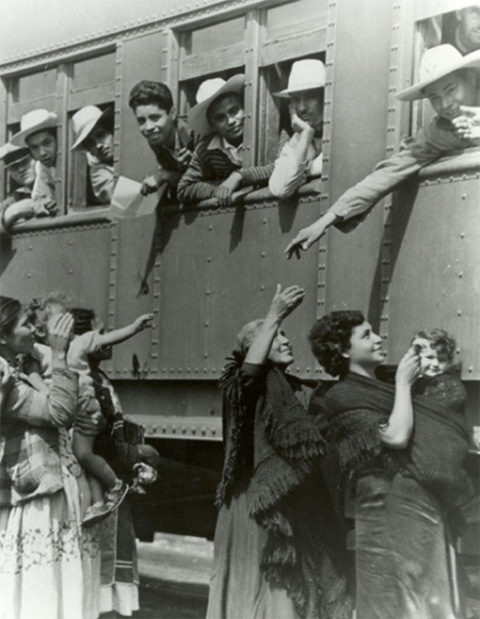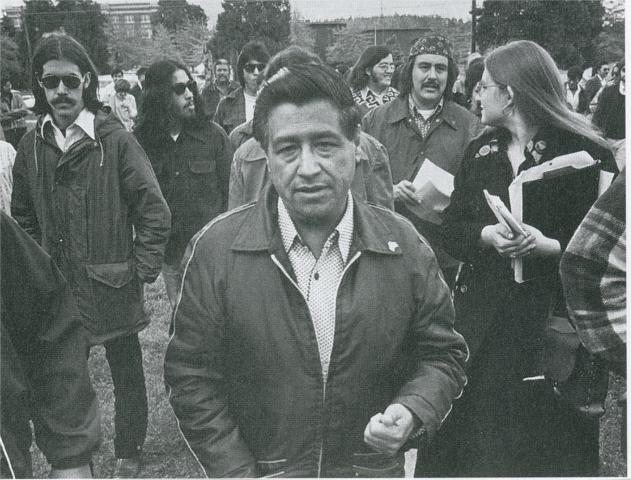Latino and Hispanic History, People
César Chávez Day in Napa
by Kilian Fitzgerald
One of the major issues of the 2016 Presidential election is illegal immigration and how to respond to it. In the spirit of César Chávez Day, let’s take a look at his life and the impact his movement had on California and the United States.

In the early twentieth century life was extremely hard for Latino and Hispanic people. Following the end of World War I, the Stock Market Crash of 1929 and the beginning of the Great Depression, Hispanophobia and xenophobia began to rapidly spread throughout poverty stricken America. Under the authority of President Herbert Hoover, the Bureau of Immigration (later the U.S. Immigration and Naturalization Service branch of the U.S. Department of Labor) began deporting or “repatriating” millions of Mexican immigrants and citizens naturalized under the 14th Amendment, often with very forcible tactics. Historians vary on the precise number of “repatriated” immigrants and citizens, however the impact of the deportations devastated the lives of many families, similar to the impact of the Japanese Internment Camps enacted by Hoover’s successor, President Franklin Delano Roosevelt.
The Bracero Program was enacted in 1942 shortly after the U.S. entered World War II. It was an attempt to compensate for the economic hole left by the enlisted American soldiers. The program brought over Mexican workers – dubbed braceros for the Spanish word meaning “manual laborer” – to work in the agricultural industry as guests without real citizenship, similar to the green card program today.
The Bracero Program was very controversial, despite the program having strict guidelines dictating when the workers could be hired and various subsidies and benefits such as free transportation back to Mexico when a braceros’ contract ended. It also set a minimum wage, and an article in the St. Helena Star reported that in 1961 a bracero earned 25 cents per box of grapes. Unfortunately, many employers ignored these guidelines and used the braceros as a form of cheap and expendable labor. This resulted in the braceros frequently being exploited by their employers and rampant Hispanophobia spread by farm workers whose positions were being filled by employers seeking a cheaper alternative.
Following the Allied victory in WWII, the enlisted American soldiers returned home to find an America with a wounded postwar economy and a nation with a growing Hispanic population. President Truman ended the Bracero Program in 1951. In 1954 President Dwight D. Eisenhower, buoyed by a report from the Commission on Migratory Labor that blamed postwar labor low wages on illegal immigrants and illegal immigration, enacted a one year deportation program called Operation Wetback. Named after a derogatory insult for illegal immigrants, and in today’s world, a racial slur, Operation Wetback, like the repatriation movement, forcibly deported thousands of Mexican immigrants and American citizens, displacing countless families. Operation Wetback ended in the fall of 1954 due to a decline in funding and complaints from Mexico.

César Estrada Chávez was born in Yuma, Arizona, on March 31, 1927. Growing up in Arizona, Chávez quickly came to know and experience the oppression and discrimination that he would work to overcome throughout his life, such as how his father was conned out of his home due to the actions of white Americans and the racism he and other Hispanic students suffered in school.
Chávez and his family eventually moved to California where he attended thirty-seven schools due to his father having to travel for his work. The hectic life drove him to drop out before entering high school to become a migrant farmer worker like his father. In 1946 Chávez served in a still segregated Navy at the age of 19. Two years after his service ended, Chávez married Helen Fabela and moved to Delano, California, where he started his family.
Throughout the twentieth century, farm workers, especially those of Latino or Hispanic origin, were often treated very poorly. Many were denied minimum wages and forced to deal with unsanitary living conditions, due in part to a lack of farm workers unions and regulations on agricultural industries. In 1962, Chávez , alongside Dolores Huerta, another famous Chicano rights activist, formed the National Farm Workers Association (NFWA) which later became the United Farm Workers (UFW). Where other organizations failed, the National Farm Workers Association succeeded largely because of the leadership of Chavez and Huerta.
Influenced by the nonviolent philosophies of St. Francis and Gandhi, Chávez strove to utilize peaceful protests and to unite farm workers in the cause. As their movement gained support and headway, Chávez would undergo several fasts for the NFWA, the first lasting 25 days, the second 24 days, and the third and final fast lasting 36 days. During these fasts heonly permitted himself water. Eventually, the NFWA won and the rights of farmworkers began to be upheld by agricultural industries.
Today Napa is enriched by its Hispanic population. During the Bracero Program, over a hundred Braceros came to work in Napa’s agricultural industries. Many of their descendants still remain in Napa County. Some own their own vineyards, like Rosa Segura, co-owner of Encanto Vineyards, whose father, Don Enrique Segura, signed up for the Bracero Program in 1946.
Chávez died in his sleep on April 23, 1993, near the Yuma farm where he was born. Many speculate that the fasts he underwent during his struggle lead to his death. In death, he left behind an incredible legacy. Through nonviolent means, Chávez had dramatically improved the lives and rights of Hispanic farmworkers and had struck a major blow against prejudice.
He is honored on March 31 with his own holiday that is celebrated in many states. California in particular designates César Chávez Day as a state holiday. Napa residents usually celebrate Cesar Chavez Day with festivals, parties, and events that celebrate our local Hispanic heritage. On March 29, 2015, statues were constructed in Napa’s Veteran’s Memorial Park of César Chávez and Dolores Huerta to honor their legacies in Napa. Chávez is also honored with a place on Napa’s Hispanic heritage mural on First Street.
On the 89th anniversary of César Chávez’s birth, it is worth reflecting on the challenges we face today, learn from our actions in the past, and keep Chávez s own words in mind during this tumultuous time: “Kindness and compassion toward all living things is a mark of a civilized society. Conversely, cruelty, whether it is directed against human beings or against animals, is not the exclusive province of any one culture or community of people. Racism, economic deprival, dog fighting and cock fighting, bullfighting and rodeos are cut from the same fabric: violence. Only when we have become nonviolent toward all life will we have learned to live well ourselves.”
Bibliography:
Center for History and New Media. “About.” braceroarchive.org. Accessed January 21, 2016. http://braceroarchive.org/about.
Florido, Adrian. “Mass Deportation May Sound Unlikely, But It’s Happened Before.” npr.org. Last modified September 21, 2015. Accessed January 23, 2016. http://www.npr.org/sections/codeswitch/2015/09/08/437579834/mass-deportation-may-sound-unlikely-but-its-happened-before.
Gross, Terry. “America’s Forgotten History Of Mexican-American ‘Repatriation.’” npr.org. Last modified September 10, 2015. Accessed January 20, 2016. http://www.npr.org/2015/09/10/439114563/americas-forgotten-history-of-mexican-american-repatriation.
“History of the UFW.” laits.utexas.edu. Accessed January 15, 2016. http://www.laits.utexas.edu/jaime/cwp2/ccg/historyofufw.html.
Immigrationtounitedstates.org. “U.S. Bureau of Immigration.” http://immigrationtounitedstates.org. Accessed January 25, 2016. http://immigrationtounitedstates.org/394-us-bureau-of-immigration.html.
Matador Network. “IN NAPA, MEXICAN AMERICANS HAVE GONE FROM MIGRANT WORKERS TO VINEYARD OWNERS. HERE ARE 10 LATINO-OWNED WINERIES TO VISIT.” matadornetwork.com. Last modified October 1, 2015. Accessed February 9, 2016. http://matadornetwork.com/pulse/n-napa-mexican-americans-gone-migrant-workers-vineyard-owners-10-latino-owned-wineries-visit/.
Napa Valley Register. “Mural teaches Napans about history/culture.” napavalleyregister.com. Last modified April 11, 2002. Accessed February 4, 2016. http://napavalleyregister.com/news/opinion/mural-teaches-napans-about-history-culture/article_27d4fbaf-5846-53df-9648-befc6a2270cd.html.
Peralta, Eyder. “It Came Up In The Debate: Here Are 3 Things To Know About ‘Operation Wetback.’” npr.org. Last modified November 11, 2015. Accessed January 20, 2016. http://www.npr.org/sections/thetwo-way/2015/11/11/455613993/it-came-up-in-the-debate-here-are-3-things-to-know-about-operation-wetback.
Stoneberg, David. “Stories, wines from Mexican-American vintners.” napavalleyregister.com. Last modified March 26, 2014. Accessed February 10, 2016. http://napavalleyregister.com/star/business/stories-wines-from-mexican-american-vintners/article_c03ff504-b516-11e3-9b3e-0019bb2963f4.html.
Time and Date AS. “http://www.timeanddate.com/holidays/us/cesar-chavez-day.” timeanddate.com. Accessed January 27, 2016. http://www.timeanddate.com/holidays/us/cesar-chavez-day.
United Farm Workers. “Education of the Heart- Quotes by Cesar Chavez.” ufw.org. Accessed February 9, 2016. http://www.ufw.org/_page.php?menu=research&inc=history/09.html.
“The Story of Cesar Chavez.” ufw.org. Accessed January 27, 2016. http://www.ufw.org/_page.php?menu=research&inc=history/07.html.
Visit Napa Valley. “Cesar Chavez/Dolores Huerta Day.” visitnapavalley.com. Last modified March 29, 2015. Accessed January 16, 2016. http://events.visitnapavalley.com/event/detail/441904793/Cesar_ChavezDolores_Huerta_Day.
Yune, Howard. “Napa to host dedication of Cesar Chavez, Dolores Huerta statues.” napavalleyregister.com. Last modified March 24, 2015. Accessed February 1, 2016. http://napavalleyregister.com/news/local/napa-to-host-dedication-of-cesar-chavez-dolores-huerta-statues/article_cb9bdacb-137c-5eff-99fa-bd63f0b462cd.html.
“Statues of Cesar Chavez, Dolores Huerta unveiled in Napa.” napavalleyregister.com. Last modified March 29, 2015. Accessed February 1, 2016. http://napavalleyregister.com/news/local/statues-of-cesar-chavez-dolores-huerta-unveiled-in-napa/article_effceee6-3dea-53f6-a8bf-ee7aad1ab5d7.html.


